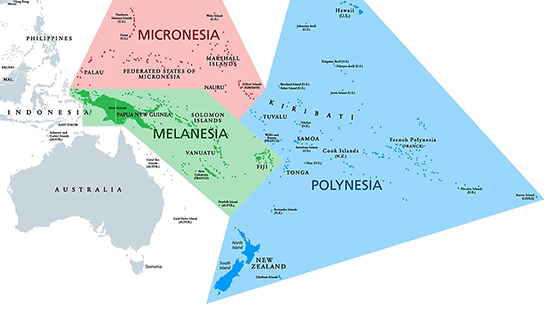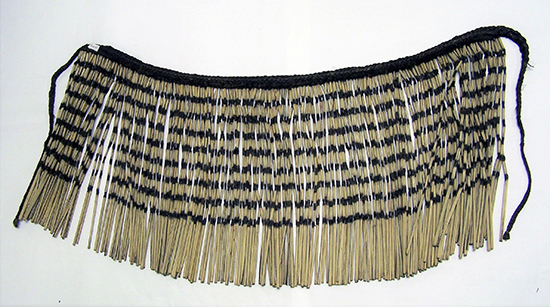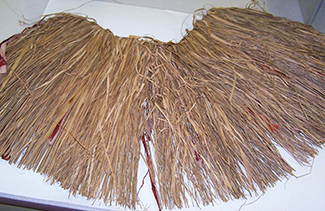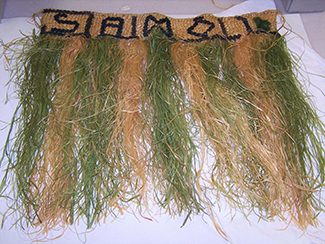Polynesia: Make a Grass Skirt
Where is Polynesia?
The Pacific Islands are divided into three geographic and cultural regions: Polynesia, Melanesia, and Micronesia. Polynesia includes islands scattered across a triangle shaped area covering the east-central region of the Pacific Ocean. Some islands within this region are the Hawaiian Islands, New Zealand, Rapa Nui (Easter Island), the Samoan islands, the Cook Islands, and Tahiti.

Traditional Skirts
Today we think of a grass skirt as a costume or garment made from layers of plant fibers or grasses that is fastened at the waist. However the term “grass skirt” has always been a misnomer.
Traditionally, Polynesian cultures used strips of natural fibers, barks, leaves, and other materials to create various types of skirts. There is a skirt-like garment in the Maori culture which is made of woven or plaited flax fibers. It is called a piupiu and is worn during Maori cultural dances. Both men and women in the Nauru culture wear a bushy skirt made of thin strips of palm-leaves. Called a ridi, it can be short, knee-length or ankle-length. In Tonga, the skirt is called a sisi pueka and is worn in dance performances. Woven from tree fibers, kapa cloth skirts for women and malos (loincloths) for men were the traditional garments of Hawaiian hula kahiko.

This traditional Maori skirt from the Lam Museum collection is made from flax wrapped in cane segments.
More than just decoration, the purpose of such skirts was and is to accentuate a dancer’s movements.
Why Grass Skirts?

This grass skirt in the Lam Museum collection is from Samoa.
Grass skirts were introduced to Hawaii by immigrants from the Gilbert Islands (small atolls that are part of the Pacific island nation of Kiribati today) in the 1870s and 1880s although their origins are attributed to Samoa as well.
Historians note that by the end of the 19th century Hawaiian dancers in both Hawaii and the mainland US began wearing grass skirts while performing on the vaudeville circuit. Because traditional Hawaiian skirts were made with fresh ti leaves, which were not available in the United States, skirts were made with grasses. Grass skirts were notable in the 1893 World’s Columbian Exposition in Chicago where Hawaiian hula dancers played into American stereotypes by wearing the costume. Some hula dancers still wear grass skirts today.
Popularity of Grass Skirts

This Samoan grass skirt from the Lam Museum collection was made to sell to tourists.
Starting in the late 19th-century and through World War II, grass skirts became a symbol of the South Seas and Polynesian cultures. Many sailors and servicemen returning from duties in the Pacific brought grass skirts home as souvenirs. The war helped to create a national interest in Polynesian food and décor. During the 1950s and 1960s, books, musicals, TV shows, films, and restaurants continued to fuel the US’s interest in Polynesian cultures. That interest continues even today.
Check out this link to learn more about grass skirts.
Let’s make a skirt!
These videos show two different ways to make a grass skirt.
To make a very simply skirt, you will need:
• Plastic table cloth or trash bag
• Glue stick
• Scissors
• Velcro (small piece)
To make a more detailed skirt, you will need:
• Jute
• Tape measure
• Scissors
• Straw or raffia (You could also use a plastic table cloth or trash bag)
• Rubber bands (for tassels)

